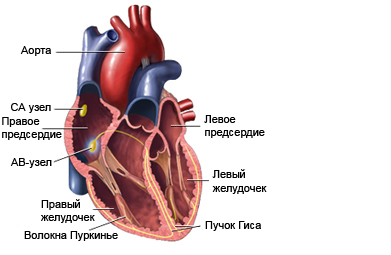Coarctation of the aorta in children
Coarctation of aorta in children description
The aorta is the main artery, which carries oxygen-rich blood from the heart to the body. Coarctation of the aorta – narrowing of the aorta, that slows down or blocks the blood flow. The disease is often associated with other cardiovascular disorders, such as heart valve abnormalities or bulging blood vessels (Aneurysm), that can cause additional problems in the future.

Causes of coarctation of the aorta in children
Coarctation of the aorta is a congenital heart disease, meaning, that it is present at birth. This is due to problems with the development of the aorta, when the fetus develops in the womb.
Risk factors for aortic coarctation in infants
Factors, that increase the likelihood of coarctation of the aorta in children:
- Paul: male;
- Syndrome Ternera;
- Anomalies of the aortic valve.
Symptoms of coarctation of the aorta in children
If the status of the child is a heavy, He will have signs of blood at birth. If the koarktaciju of the aorta is not treated, This can lead to heart failure.
If the disease has not been detected in infancy, the following may appear in childhood symptoms:
- Heart murmur;
- High blood pressure in the hands;
- Weak pulse in my feet;
- Cold feet;
- Breathlessness, especially during physical exercise;
- Underdeveloped legs, though, that hands developed normally;
- Headache;
- Dizziness;
- Fatigue;
- Chest pain.
These symptoms may be caused by other diseases. If your child has any of these, You must show it to the doctor.
Diagnosis of coarctation of the aorta in children
If the disease is not detected at birth of child, the doctor asks about his symptoms and medical history. It will also make medical inspection. Tests may include:
- Blood tests;
- Chest X-ray – to take a picture of structures inside the chest;
- MRI cardiac – test, which uses magnetic waves, to take pictures of structures inside the heart
- CT scan (CT) hearts – type of X-ray inspection, wherein the computer is used, to take pictures of structures inside the heart;
- Echocardiogram – test, which uses high-frequency sound waves (ultrasound), to examine the size, shape and motion of the heart;
- Heart catheterization – special tool inserted into the heart through a vein or artery (usually in the arm or leg), to detect problems with the heart and its blood supply.
Treatment for coarctation of the aorta in children
Treatment depends on the age of the child and the seriousness of the disease.
Treatment of newborn
Newborn needs immediate treatment. Intravenous can be administered drugs called prostaglandins. They help to direct blood flow to all parts of the body. To improve the work of the heart can also be used other medicines. One of the most common operations involves the removal of the suzhennnogo plot of the aorta and connection of two healthy its ends.
Treatment of children
Child, perhaps, take allergy pills, to reduce fluid retention. Depending on the condition of the child, your doctor may recommend surgery. Some options include surgery:
- Resection of the narrowed aorta uchastkav (the same type of operation, which is used for babies);
- Aortoplastika flap of the left subclavian artery – includes brass part of the receptacle, cut out another artery, to widen the narrowed scope;
- Ballonnaя angioplasty – a small balloon (balloon), to widen the narrowed plot.
It is important to note, Despite operation, even in adulthood, there will always be a risk of various cardiovascular diseases.
Prevention of aortic coarctation in infants
Because aortic coarctation is a congenital disease, methods of its prevention does not exist.
